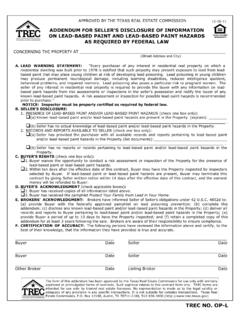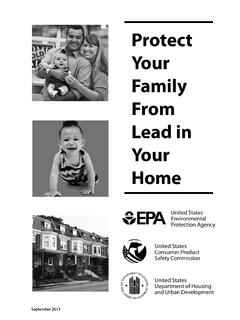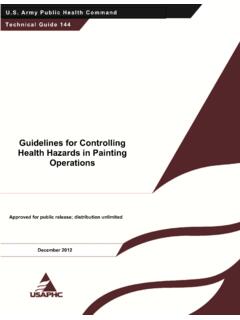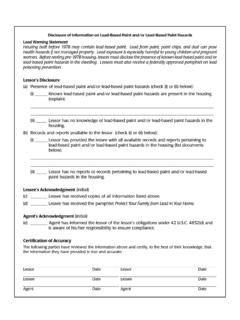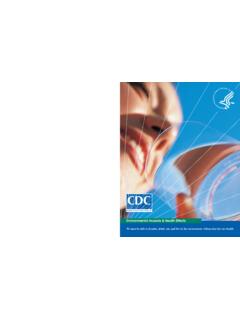Transcription of A MATERIAL SAFETY DATA SHEET LEAD(II)IODIDE
1 A MATERIAL SAFETY DATA SHEETLEAD(II) Product Identifiers:Product Name:Lead(II) iodideCAS No Relevant identified uses of the substance or mixture and uses advised againstIdentified uses:Laboratory chemicals, Manufacture of Details of the supplier of the SAFETY data sheetSupplier: Infinium Pharmachem Pvt. Ltd. (AN ISO 9001:2008 CERTIFIEDCO.)38, , SojitraDist: ANANDG ujarat, IndiaTel : 0091-2697-234987 Fax : 0091-2697-234987 Email : Lead diiodide; Lead diiodide (PbI2); Lead iodide; Lead(II) iodide; PlumbousiodideCAS No. : 10101-63-0 Molecular Weight : 461,01 g/molChemical Formula : Classification of the substance or mixture Classification according to Regulation (EC) No 1272/2008 [EU-GHS/CLP]Acute toxicity, Oral (Category 4), H302 Acute toxicity, Inhalation (Category 4), H332 Reproductive toxicity (Category 1A), H360 Specific target organ toxicity - repeated exposure (Category 2), H373 Acute aquatic toxicity (Category 1), H400 Chronic aquatic toxicity (Category 1)
2 , H410 For the full text of the H-Statements mentioned in this Section, see Section according to EU Directives 67/548/EEC or 1999/45/ECR61R62Xn Harmful R20/22R33N Dangerous for theR50/53 Environment For the full text of the R-phrases mentioned in this Section, see Section Label elementsPictogram Signal word DANGERH302 + H332 Harmful if swallowed or if inhaledH360 May damage fertility or the unborn May cause damage to organs through prolonged or repeated Very toxic to aquatic life with long lasting statement(s)P201 Obtain special instructions before Avoid release to the + P313IF exposed or concerned: Get medical advice/ Dispose of contents/ container to an approved waste disposal HazardStatements noneRestricted to professional Other hazardsThis substance/mixture contains no components considered to be either persistent, bioaccumulative and toxic (PBT), or very persistent and very bioaccumulative (vPvB) at levels of or higher.
3 Description of first aid measuresGeneral adviceConsult a physician. Show this SAFETY data SHEET to the doctor in inhaledIf breathed in, move person into fresh air. If not breathing, give artificial case of skin contactWash off with soap and plenty of case of eye contactFlush eyes with water as a swallowedNever give anything by mouth to an unconscious person. Rinse mouth with Most important symptoms and effects, both acute and delayedThe most important known symptoms and effects are described in the labelling (see ) and/or in section Indication of any immediate medical attention and special treatment neededno data Extinguishing Media: Suitable extinguishing mediaUse water spray, alcohol-resistant foam, dry chemical or carbon Special hazards arising from the substance or mixtureHydrogen iodide, Lead Advice for firefightersWear self contained breathing apparatus for fighting if Further Information No data Personal precautions, protective equipment and emergency proceduresUse personal protective equipment.
4 Avoid dust formation. Avoid breathing vapours, mist or gas. Ensure adequate ventilation. Evacuate personnel to safe areas. Avoid breathing personal protection see section Environmental precautionsPrevent further leakage or spillage if safe to do so. Do not let product enter drains. Discharge into the environment must be Methods and materials for containment and cleaning upPick up and arrange disposal without creating dust. Sweep up and shovel. Keep in suitable, closed containers for Reference to other sectionsFor disposal see section Precautions for safe HandlingAvoid contact with skin and eyes. Avoid formation of dust and exposure -obtain special instructions before appropriate exhaust ventilation at places where dust is precautions see section Conditions for safe Storage, including any incompatibilitiesStore in cool place.
5 Keep container tightly closed in a dry and well-ventilated class (TRGS 510): Non-combustible, acute toxic / toxic hazardous materials orhazardous materials causing chronic Specific end usesApart from the uses mentioned in section no other specific uses are Control parameters Components with workplace control Exposure ControlsAppropriate engineering controlsHandle in accordance with good industrial hygiene and SAFETY practice. Wash hands beforebreaks and at the end of protective equipmentEye/face protectionSafety glasses with side-shields conforming to EN166 Use equipment for eye protectiontested and approved under appropriate government standards such as NIOSH (US) or EN166(EU).Skin protectionHandle with gloves. Gloves must be inspected prior to use. Use proper glove removaltechnique (without touching glove's outer surface) to avoid skin contact with this of contaminated gloves after use in accordance with applicable laws and goodlaboratory ractices.
6 Wash and dry selected protective gloves have to satisfy the specifications of EU Directive 89/686/EECand the standard EN 374 derived from ProtectionComplete suit protecting against chemicals, The type of protective equipment must beselected according to the concentration and amount of the dangerous substance at the protectionWhere risk assessment shows air-purifying respirators are appropriate use a full-face particlerespirator type N100 (US) or type P3 (EN 143) respirator cartridges as a backup to engineering controls. If the respirator is the sole means of protection, use a full-face supplied air respirator. Use respirators and components tested and approved under appropriate government standards such as NIOSH (US) or CEN (EU).Control of environmental exposurePrevent further leakage or spillage if safe to do so.
7 Do not let product enter drains. Discharge into the environment must be Information on Basic physical & chemical propertiesa) Appearance Form: powderColour: blackb) Odor no data availablec) Odor Threshold no data availabled) pH no data availablee) Melting point/freezing Melting point/range: 402 C - lit. Pointf) Initial boiling point and 954 C - lit. Boiling rangeg) Flash point not applicableh) Evaporation rate no data availablei) Flammability (solid, gas) no data availablej) Upper/lower no data available Flammability or explosive limitsk) Vapor pressure 1 hPa at 479 Cl) Vapor density no data availablem) Relative density 6,16 g/mL at 25 Cn) Water solubility no data availableo) Partition coefficient: n-octanol /water no data availablep) Auto ignition no data available Temperatureq) Decomposition no data available Temperaturer) Viscosity no data availables) Explosive properties no data availablet) Oxidizing properties no data Other SAFETY Informationno data Reactivityno data Chemical stabilityno data Possibility of hazardous reactionsno data Conditions to Incompatible materialsStrong oxidizing agents.
8 Hazardous decomposition productsOther decomposition products - No data availableIn the event of fire: see section Information on toxicological effectsAcute toxicityno data availableSkin corrosion/irritationno data eye damage/eye irritationno data availableRespiratory or skin sensitizationMay cause allergic skin cell mutagenicityno data availableCarcinogenicityPossible human carcinogenIARC: 2A - Group 2A: Probably carcinogenic to humans (Lead diiodide)Reproductive toxicityMay cause congenital malformation in the human reproductive toxicantSpecific target organ toxicity - single exposureno data availableSpecific target organ toxicity - repeated exposureMay cause damage to organs through prolonged or repeated hazardno data availableAdditional InformationRTECS: Not availableanemia, Prolonged exposure to iodides may produce iodism in sensitive of exposure include: skin rash, running nose, headache and irritation of themucous membrane.
9 For severe cases the skin may show pimples, boils, hives, blisters andblack and blue spots. Iodides are readily diffused across the placenta. Neonatal deaths fromrespiratory distress secondary to goiter have been reported. Iodides have been known to causedrug-induced fevers, which are usually of short duration., Lead salts have been reported tocross the placenta and to induce embryo- and feto- mortality. They also have teratogeniceffect in some animal species. No teratogenic effects have been reported with exposure toorganometallic lead compounds. Adverse effects of lead on human reproduction, embryonicand fetal development, and postnatal ( , mental) development have been exposure can affect blood, nervous, and digestive systems. The synthesis ofhemoglobin is inhibited and results in anemia.
10 If left untreated, neuromuscular dysfunction,possible paralysis, and encephalopathy can result. Additional symptoms of overexposureinclude: joint and muscle pain, weakness of the extensor muscles (frequently the hand andwrist), headache, dizziness, abdominal pain, diarrhea, constipation, nausea, vomiting, blueline on the gums, insomnia, and metallic taste. High body levels produce increasedcerebrospinal pressure, brain damage, and stupor leading to coma and often Persistence and Toxicityno data Persistence and degradabilityno data Bioaccumulative potentialno data Mobility in soilno data Results of PBT and vPvB assessmentThis substance/mixture contains no components considered to be either persistent,bioaccumulative and toxic (PBT), or very persistent and very bioaccumulative (vPvB) atlevels of or higher.



